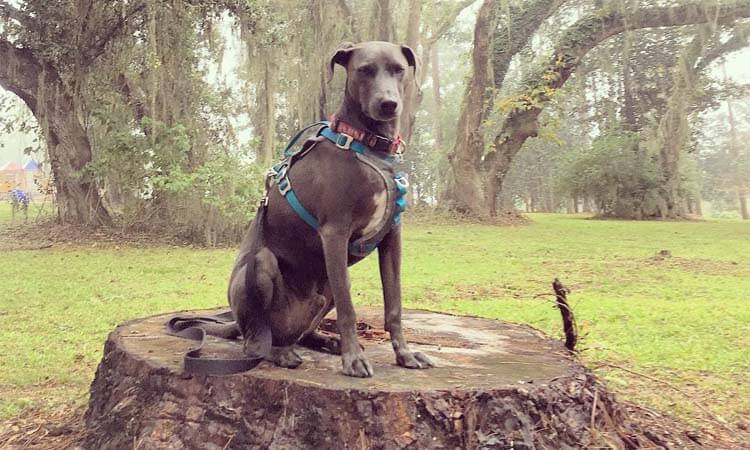Blue Lacy dog is also known as Lacy dog, originated in Texas in the mid-19th century. The blue Lacy dog is the only dog known to be an original breed from Texas. Lacy is a working dog with a working attitude. They have endless heart and drive. Lacy Dogs are very intelligent and can pick up tasks quickly, but owners often say they are too smart for their good.
Blue Lacy content overview
- History
- Different names
- Appearance and Characteristics
- Personality and Temperament
- Health & problems
- How to take care
- Puppy Information
- Puppy price
- Things to consider adopting a puppy
- Advantages & Disadvantages
- Photo gallery
History of Blue Lacy
The Lacy dog was named after the Lacy brothers Frank, George, Ewin, and Harry, who moved from Kentucky to Texas in 1858 and settled in the Hill Country. The breed was developed for just that purpose, to be a perfect all-around dog. According to the Lacy family, the dog was a mixture of English Shepherd, greyhound, and wolf. The blue Lacy faced near extinction in the early to mid-1900s due to new ranching technology that reduced the need for canine herding support.
The National Lacy Dog Association exists to promote and preserve the breed and its working ability. The breed is registered by the National Lacy Dog Registry and the Animal Research Foundation. In 2005, the Blue Lacy was named the Official State Dog Breed of Texas by the Texas Legislature and Governor.
Today, the Texas Blue Lacy is still used in southwestern U.S. states for ranch work and hunting. They also make good companion dogs and excellent search and rescue dogs.
Lacy generally exhibit herding instincts and can be trained to compete in stock dog trials or hog bays. During recent years, Lacy dogs have also become recognized for their great tracking skills and sought after to be used to locate “lost” game animals.
Different names or Types
Other Names of Blue Lacy dog
- Blue Lacy Game Dog
- Lacy Dog
- Lacy Game Dog
- Red Lacy
- Lacy Hog Dog
- Texas Blue Lacy
- Texas Blue Lacy Game Dog
- Lacy Cur
- Texas State Dog
- Texas Lacy Dog
Recognized Names
Recognition
- Texas Lacy Game Dog Association – TLGDA
- American Canine Association Inc – ACA
- National Lacy Dog Association – NLDA
- Lacy Dog Breeders Association – LDBA
- Universal Kennel International – UKI
- Dog Registry of America, Inc – DRA
- American Pet Registry, Inc – APRI
- American Canine Registry – ACR
- Lacy Game Dog Registry – LGDR
- Continental Kennel Club – CKC
- National Kennel Club – NKC
Appearance & Characteristics
The Blue Lacy is a medium-sized breed. The average Blue Lacy stands between 18 and 25 inches tall at the shoulder, with females being shorter than males.
Breed basic characteristics
| Origin | Texas |
| Group | Herding |
| Size: | Medium |
| Lifespan: | About 16 years |
| Trainability: | Moderate Effort Required |
| Exercise Needs: | Lots of leadership and exercise |
| Grooming: | Low maintenance |
| Barking: | Constantly barking |
| Shedding: | Minimal Shedding |
| Protective Ability: | Good with Kids |
| Brushing: | Once a Week or Less |
| Hypoallergenic Breed: | No |
| Space Requirements: | House with yards |
| Compatibility With Other Pets: | Good |
| Average Puppy Price: | Average $600 – $800 USD |
| Height | 18-25 inches |
| Weight | 25-50 pounds |
| Litter size | 3-8 Puppies |
Sound
Behavior
Blue Lacies are a very pack oriented breed and may fight other household dogs for dominance. The Blue Lacy is very frequently used as a hunting dog, and more breed members show very high levels of aggression towards other animals.
Size, Proportion, Substance
Size: Height at the withers is from 43 to 56 cm. Weight should be approximately 11 to 20 kg for females and 16 to 25 kg (35 to 55 lb) for males.
Proportion:
Substance:
Serious Faults:
Head
The head and face of the Blue Lacy are very similar to those of other Cur breeds. The head is long, narrow, and not domed.
Skull:
Muzzle: The muzzle and skull remain distinct but blend in quite smoothly with each other. The muzzle itself is quite long.
Eyes: The eyes of the Blue Lacy are almond-shaped. It is preferred that the eyes should be amber in color regardless of the color of the dog’s coat, but some blue dogs have grey eyes.
Ears: The ears of the Blue Lacy dropdown. Most dogs have ears that fold down close to the head’s sides, although some do fold backward like that of many Pit Bulls.
Teeth: The teeth should meet in a scissors bite. A level bite is a fault.
Serious Faults:
Neck, Topline, Body
Neck: The neck is of medium length, is firm, elegant and muscular, clean and arched at the crest, setting well into the shoulders.
Topline: The top line appears level at a natural four-square stance. Roach back or sway back must be penalized.
Body: The body is firm and muscular. The chest is deep and comes to the elbow, with ribs that are well sprung but are not slab-sided or round.
Serious Faults:
Forequarters
Shoulders: The shoulders are well laid back, measuring about three fingers apart at the tips of the withers and are well muscled.
Forelegs: The legs are straight and powerful. Pasterns are straight and strong but are still flexible.
Front Feet: Feet are spoon-shaped, compact with close-knit and well-arched toes.
Hindquarters
Thighs are strong and well-muscled. Angulation of both the stifle and hock joint should achieve the optimal balance of drive and traction. When viewed from the rear, the hocks are parallel to each other and low to the ground. Lacy dogs should have slightly rounded croup and muscular thighs. Cow hocked legs are a fault.
Rear Legs:
Hind Feet:
Tail: Set low or neither high nor low on the croup, always like a natural extension of the top line. It is thick at the base and tapering toward the tip.
Coat
The coat of the Blue Lacy is short, glossy, and very close. The texture ranges from very fine to slightly harsh.
Winter Coat:
Summer Coat:
Shedding: Minimal Shedding: This dog will shed a negligible amount. They are recommended for owners who do not want to deal with dog hair in their cars and homes.
Color and Markings
The Blue Lacy is found in five acceptable colors: solid blue, solid gunmetal grey, solid red, solid cream, and tricolor.
Coat Color and Markings
Gait: Smooth, free and easy; exhibiting agility of movement with a well balanced, ground covering stride.
Personality and Temperament
Blue Lacy Personality
A medium-sized, well-built dog may be called the ‘Blue’ Lacy but can come in various colors. The Blue Lacy is usually classified as a type of Cur. Many people believe that a Cur is a mixed-breed or undesirable dog, but this is only accurate for the term’s use in Great Britain and Ireland.
Temperament
Blue Lacies are generally very devoted to their families. This breed forms very strong bonds with its owner. This dog craves its family’s constant company, and many breed members suffer from severe separation anxiety. These dogs are energetic and driven to fulfill any task. They need plenty of stimulation and interaction. The best match for a Lacy is either a farmer, hunter, or a very active individual.
Activity Requirements
Lacy is a working breed and does much better when given a job, which allows them to burn off excessive energy. Modern activities like agility that stress intelligence, passion, speed, and skill may be appropriate substitutes for traditional work. High energy might be the first thing that comes to mind when talking about Blue Lacys, and they require multiple long runs and walks each day to burn off all that energy.
Behavioral Traits
Lacy Dogs make great working companions. They do not make great pets. Lacy tends to be a very pack-oriented dogs and needs a strong leader that sets clear boundaries. If you are interested in this breed, do your research and be prepared to live with a working dog. Lacy can be a loyal companion in the right home who will work with incredible drive and determination.
Trainability
The Blue Lacy is intelligent, eager to work, energetic, and fast. They are easy to train and handle when working as herding, baying, tracking, and hunting dogs. Training the Blue Lacy can be an impossible task for an inexperienced owner.
Health & problems
Blue Lacy Health & Problems
Lacys are a generally healthy breed, with an expected lifespan of 12 to 16 years. They are not known to suffer from severe health problems apart from food allergies and skin issues. They are also reported to be afflicted with a rare condition, color dilution alopecia, where its coat has patches.
Daily, regular inspections of your blue lacy for fleas and ticks throughout the summer are important. You can remove and find fleas using a flea comb. There are several new procedures for flea and tick elimination. Get advice from your veterinarian about his or her recommendations.
They can develop joint problems such as hip dysplasia or elbow dysplasia, and some are prone to skin problems, hypothyroidism, and food allergies. Occasionally, blue and tricolor Lacys may have a rare condition called color dilution alopecia (CDA), which causes hair loss and skin problems.
Feeding Plan
- Blue Lacy pups between 8 and 12 weeks old need 4 meals in 24 hours.
- Blue Lacy puppies, 3 to 6 months old, should be fed 3 meals per day.
- Feed pups 6 months to one-year-old two meals in a day.
- When the blue lacy reaches his first birthday, one bowl in a day is enough.
- Sometimes blue lacy, however, prefer two lighter meals. It’s your job to adapt to your blue lacy’s eating schedule.
High-quality dry dog food ensures a well-rounded diet to grown blue lacy and may be mixed with canned food, broth, or water. Your blue lacy may also dig fruits and vegetables, cottage cheese, and cooked eggs, but these additions should not be more than 10 pct of his daily food.
Living conditions
They adapt well to any living conditions. They make good house dogs but also love being outdoor dogs as well. Easy to train for house or outside.
How to take care?
Exercise
The Blue Lacy is renowned for its zest for work and endurance. It can become a significant challenge even for an active owner to meet its essential exercise needs. Exercise also seems to help blue lacy avoid boredom, which often can lead to destructive behavior.
Lacys generally exhibit herding instincts and can be trained to compete in stock dog trials or hog bays. During recent years, Lacy dogs have also become recognized for their great tracking skills and sought after to be used to locate “lost” game animals.
Grooming & Bruising
The Blue Lacy coat sheds a moderate amount at usual times and then very heavy seasonal shedding sometimes, so there will be some hair around the home in general, and then a lot occasionally.
Dental Health Check-up
Dental disease is the most common chronic problem in pets, affecting 80% of all dogs by age two. And unfortunately, your Lacy Dog is more likely than other dogs to have problems with her teeth. It starts with tartar build-up on the teeth and progresses to infection of the teeth’ gums and roots.
Proper dental health care is important for every dog; similarly, it is very important for the Lacy Dog. Brush your dog’s teeth at least 2 or 3 times a week. You get a special toothbrush for dogs, and your vet can guide you on how to use them. If you don’t attend to your pet’s teeth, he can experience tartar build-up. It can lead to gum disease and tooth loss. Not only that, bad teeth can affect other parts of the body too.
Love & affection
Love and affection are useful for every dog. Suppose you give love and affection to your Lacy dog, then the dog will love you back. Your Blue Lacy puppy will be a member of your family, So Give lots of love and affection to your cute puppy. Most importantly, spend time with your dog because that your dog needs love and affection.
Feed Healthy food
Feeding healthy food in the dog’s life is the most important. On this day, there are many healthy foods available on the market so that you can choose any healthy food for your dog. Healthy food is the most important for dog health care. The young Lacy dog is not a hearty eater as most breeds his size. He must often encourage meat juices or bacon grease mix in the food to entice him to eat.
The Blue lacy should do well on high-quality dog food, whether commercially manufactured or home-prepared, with your veterinarian’s supervision and approval. In general, Lacy needs a high protein, low grain diet, which helps prevent diarrhea and bloat. Always make sure that they have clean fresh water for drinking. However, their diet needs, including the amount and frequency you feed them, will change over time as they age.
Feed your puppy several times a day so they can grow up to be big and strong. Don’t forget to provide your Lacy game dog with plenty of exercises to keep them from becoming overweight or obese.
The following items should never be feed to Lacy dog
- Alcohol, beer, wine or liquor
- Chocolate, coffee, or tea
- Grapes or raisins
- Moldy or spoiled food of any kind
- Onions, chives, and garlic
- Poultry bones
- Salt & salty foods
- Tomato leaves stem or unripe fruit
- Yeast dough
Puppy information
Puppy Training
The Lacy is bred to be easy to train and handle, although they can be a handful for first-time owners. These intelligent dogs are quick learners, adapting well to training. They are very active as puppies and are very intelligent, social, tenacious, active, and physically powerful as adults. They require considerable mental and physical challenges daily, or they, like most other breeds, can become bored, unhappy, and destructive.
Crate training
Crate Training is one of the most efficient and effective ways to train a Lacy dog puppy. It can be an efficient and effective way to house train a Blue Lacy puppy. Puppies do not like to soil their resting or sleeping quarters if given adequate opportunity to eliminate elsewhere. Crate training also helps teach your puppy to have bladder and bowel control. Instead of going whenever she feels like it, she learns to hold it and go at conveniently scheduled times.
Behavioral training
Before teaching the basic commands, it is important to establish a close emotional relationship between the dog and the owner. Behavioral training is very important for any dog. All of us, dog owners, need to administer some dog behavior training at some point in time. This training is very helpful for taking care of the dog. First of all, if you want to train your puppy to behavioral training to find out some common behavioral issues like breaking, aggression, food guarding, howling, mouthing and chewing, separation anxiety, etc., and stop these behavioral issues and train your dog easily.
Obedience training
Obedience training usually refers to a dog’s training, and the term is most commonly used in that context. This training ranges from very basic training, such as teaching the dog to reliably respond to basic commands such as “sit,” “down,” “come,” and “stay,” to high-level competition within clubs such as the American Kennel Club.
Socialization
Blue Lacys make excellent watchdogs. Through socialization, training is highly necessary to know when it is appropriate to be on guard and when to be friendly to other pets and people. Lacy’s dog requires early socialization and obedience training in some situations; the Lacy can be aggressive toward other dogs and suspicious of strangers. Socialize your puppy from a young age of 7 weeks. Expose your new dog of any age to as many other dogs and people as possible, making all of these experiences positive ones involving play and dog treats.
Puppy price
Blue lacy puppy for sale
The cost to adopt a Blue Lacy is around $300 to cover the expenses of caring for the dog before adoption. In contrast, buying Blue Lacy dogs from breeders can be prohibitively expensive. Depending on their breeding, they usually cost anywhere from $800-$1,000.
If you’re looking for a Blue Lacy, Adopt-a-Pet.com can help you find one near you. Use the search tool and browse adoptable Blue!
Find a breeder
Finding a good breeder is a great way to find the right puppy. A good breeder will match you with the right puppy and will, without question, have done all the health certifications necessary to screen out health problems as much as possible.
- Bullard, Doug & Diane
Northport – Alabama
bullardsbucksandbeards@hotmail.com
(205) 331-9527 - Widdowson, Ryan
Green Cove Springs – Florida
rewiddowson@comcast.net
(904) 608-9317 - Morris, Chris
Vermontville – Michigan
cmorris20296@yahoo.com
(517) 652-3763 - Bradshaw, Eddie & Renne
Dickson – Texas
onefrb@aol.com
(832) 250-6211 - Arnold, Michael
Victoria – Texas
michael169@suddenlink.net
(361) 212-0233
Things to consider adopting a Blue Lacy
If you are a confident dog owner and are looking for an active, intelligent, and protective dog to keep you company, then the Blue Lacy temperament may suit you perfectly.
If you’re seriously considering adopting this dog, you should know.
- Before you adopt a Lacy dog, consider how much time your new family member will spend alone. Remember, a puppy requires constant attention.
- Before you adopt a puppy, ask yourself if you can walk your dog several times throughout the day.
- You also have the advantage of knowing that your dog is physically able to “hold it” for several hours at a stretch.
- Ask anybody who has adopted an adult dog, then adopt an adult dog.
- If you’re unsure whether the new dog you’ve chosen is right for your family and lifestyle, consider fostering before committing.
Advantages of Blue Lacy
- Easy to groom
- Wonderful companion
- Excellent herder and hunter
Disadvantages of Blue Lacy
- Requires a lot of daily exercises
- Doesn’t suit for living in a small apartment
Blue Lacy Photo gallery

@jcastillo_parasnl

@zackthebluelacy


@oreothebigcookie

@janelle.jordan.photography
Got some questions? Or some suggestions? That’s why we’ve got a comments section on this blog! You can feel free to leave a comment or two down below, and we’ll get back to you as soon as possible!
We love reading your messages……
Also read: Top 10 benefits of having a Beagle